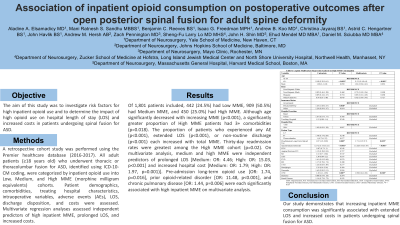Association of inpatient opioid consumption on postoperative outcomes after open posterior spinal fusion for adult spine deformity
Association of Inpatient Opioid Consumption on Postoperative Outcomes After Open Posterior Spinal Fusion for Adult Spine Deformity
Friday, April 21, 2023


Aladine A. Elsamadicy, MD
Resident Physician
Yale School of Medicine
New Haven, Connecticut, United States
ePoster Presenter(s)
Introduction: Opioids are commonly used postoperative analgesics. However, few studies have analyzed the impact of high inpatient opioid use on outcomes following spinal fusion for adult spinal deformities (ASDs). Thus, the aim of this study was to investigate risk factors for high inpatient opioid use and to determine the impact of high opioid use on hospital length of stay (LOS) and increased costs in patients undergoing spinal fusion for ASD.
Methods: A retrospective cohort study was performed using the Premier healthcare database (2016-2017). All adult patients (≥18 years old) who underwent thoracic or thoracolumbar fusion for ASD, identified using ICD-10-CM coding, were categorized by inpatient opioid use into Low, Medium, and High MME (morphine milligram equivalents) cohorts. Patient demographics, comorbidities, treating hospital characteristics, intraoperative variables, adverse events (AEs), LOS, discharge disposition, and costs were assessed. Multivariate regression analyses assessed independent predictors of high inpatient MME, prolonged LOS, and increased costs.
Results: Of 1,801 patients included, 442 (24.5%) had Low MME, 909 (50.5%) had Medium MME, and 450 (25.0%) had High MME. Although age significantly decreased with increasing MME (p < 0.001), a significantly greater proportion of High MME patients had 3+ comorbidities (p=0.018). The proportion of patients who experienced any AE (p < 0.001), extended LOS (p < 0.001), or non-routine discharge (p < 0.001) each increased with total MME. Thirty-day readmission rates were greatest among the High MME cohort (p=0.02). On multivariate analysis, medium and high MME were independent predictors of prolonged LOS [Medium: OR:4.46; High: OR:15.03,p < 0.001] and increased hospital cost [Medium: OR:1.79; High: OR:1.97,p=0.001)]. Pre-admission long-term opioid use [OR:1.74,p=0.016], prior opioid-related disorder [OR:11.48,p < 0.001], and chronic pulmonary disease [OR:1.44,p=0.006] were each significantly associated with high inpatient MME on multivariate analysis.
Conclusion : Our study demonstrates that increasing inpatient MME consumption was significantly associated with extended LOS and increased costs in patients undergoing spinal fusion for ASD.
Methods: A retrospective cohort study was performed using the Premier healthcare database (2016-2017). All adult patients (≥18 years old) who underwent thoracic or thoracolumbar fusion for ASD, identified using ICD-10-CM coding, were categorized by inpatient opioid use into Low, Medium, and High MME (morphine milligram equivalents) cohorts. Patient demographics, comorbidities, treating hospital characteristics, intraoperative variables, adverse events (AEs), LOS, discharge disposition, and costs were assessed. Multivariate regression analyses assessed independent predictors of high inpatient MME, prolonged LOS, and increased costs.
Results: Of 1,801 patients included, 442 (24.5%) had Low MME, 909 (50.5%) had Medium MME, and 450 (25.0%) had High MME. Although age significantly decreased with increasing MME (p < 0.001), a significantly greater proportion of High MME patients had 3+ comorbidities (p=0.018). The proportion of patients who experienced any AE (p < 0.001), extended LOS (p < 0.001), or non-routine discharge (p < 0.001) each increased with total MME. Thirty-day readmission rates were greatest among the High MME cohort (p=0.02). On multivariate analysis, medium and high MME were independent predictors of prolonged LOS [Medium: OR:4.46; High: OR:15.03,p < 0.001] and increased hospital cost [Medium: OR:1.79; High: OR:1.97,p=0.001)]. Pre-admission long-term opioid use [OR:1.74,p=0.016], prior opioid-related disorder [OR:11.48,p < 0.001], and chronic pulmonary disease [OR:1.44,p=0.006] were each significantly associated with high inpatient MME on multivariate analysis.
Conclusion : Our study demonstrates that increasing inpatient MME consumption was significantly associated with extended LOS and increased costs in patients undergoing spinal fusion for ASD.
